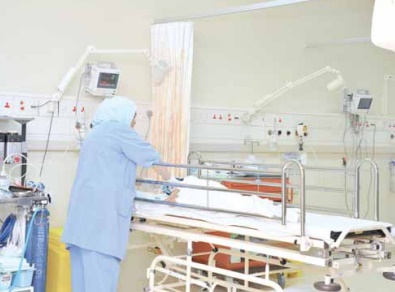

Muscat: Healthcare sector in the Sultanate has been on a continuous march to excellence since the blessed Renaissance of 1970, thanks to the government’s ‘best healthcare for all’ slogan, which has brought global accolades.
The reduction in child mortality rate has continued. The infant mortality rate per 1,000 live births declined from 118 in 1972 to 16.7 in 2000 and then to 9.5 in 2017.
The under-five mortality rate (per 1,000 live births) decreased from 181 in 1972 to 11.6 in 2017 accompanied by an increase in life expectancy at birth from 49.3 to 76.9 years.
No wonder, the World Health Organisation (WHO) appreciated Oman as one of the “fastest” countries in reducing child mortality rates in the eighties and the nineties.
The major reason behind this achievement has been attributed to the Sultanate’s efforts in controlling communicable and hazardous diseases of childhood, according to the Ministry of Health.
“The strategies adopted by the ministry led to the absence of certain diseases such as polio, diphtheria and neonatal tetanus in the Sultanate in the past two decades. There have been no cases of measles in the past two years. Hepatitis cases dropped by 68 per cent compared with 2005 and malaria was controlled,” said the media relations department at the MoH.
One out of every three individuals was suffering from malaria in 1975. A total of 241,431 malaria cases were reported at the time.
When it comes to maternal health and care, the maternal mortality rate dropped to 20.2 per 100,000 live births in 2017 compared with 26.4 in 2010, thanks to the health planning adopted by the Ministry of Health since 1976.
“The health plans of the ministry have three clear phases, each of which has distinct features and characteristics that are appropriate to the developmental situation in those phases.”
The Ninth Five Year Plan for Health Development (2016-2020) was approved in 2016. It was based on the Health System Vision (Health 2050), which represents a quantum leap in the future health planning process, where the fifth five-year plan directed its strategies and objectives through the seven themes on which the vision was based.
The multi-level healthcare sector is accentuated by the Health Vision 2050, which contains 28 visions and 142 strategic activities in order to steer the health plans to develop the system with its major components and core competencies which are leadership or governance, finance, human resources for health, health services provision, information, medical products, vaccinations, medical technology and partnership with other health-related sectors.
The preparation of Health Vision 2050 has led to the development of ‘Health Atlas’, which includes future projections of the population, the needs of health services and medical equipment.
In its 2008 report, the World Health Organization (WHO) praised the primary healthcare in the Sultanate, which achieved the eighth place in the global level in the field of primary healthcare.
A total of 46 health institutions were opened to the public in all governorates between 2010 and 2016. In 2010, five health facilities were opened, including a health complex and four health centres in Al Buraimi Governorate, Al-Daharez Health Center in Dhofar Governorate, Wadi Manqal and Al Wafi Health Centers in South Al Sharqia Governorate and Al Sawadi Health Center in Al Batinah South Governorate.
2017 saw an increase in the number of MoH’s health centres and polyclinics that reached 207 compared with 176 at the beginning of the Eighth Plan Five Year Plan for Health Development.
The number of hospital beds has increased to 5,039 (7.3 per cent increase) compared with the same period in the previous year.
The ministry has completed a number of expansions to support the provided health services. The number of these projects reached more than 30 between 2010 and 2016. The most important of these is the establishment of the Accident and Emergency Unit in each of the Sultan Qaboos Hospital in Salalah, Khasab, and Dibba, in addition to a kidney dialysis unit at Al Rustaq Hospital and Shinas Polyclinic.
In light of the country's epidemiological transition, it has been found the provision of world-class tertiary care in high-quality hospitals needs to be expanded due to the non-communicable diseases that require specialised interventions.
Learning and training is an ongoing process at the MoH and its allied organisations and it conducts training courses for employees inside and outside the country to improve their skills.
The ministry regularly sends physicians abroad to pursue their postgraduate studies in various disciplines. In 2017, it sent 132 doctors abroad for further studies compared with 100 in 2010.
The total number of training courses inside and outside the Sultanate in 2017 reached 999. They were conducted by eminent medical practitioners and lecturers.
The ministry is currently in the process of completing a number of expansion projects, which are in the process of consultancy or construction bidding. The MoH has also developed and introduced a number of specialised healthcare services in various governorates in the Eighth Five-Year Plan (2010-2015).
The Vision 2050 includes various visions for building a medical city to provide tertiary care. The construction of a medical city between the governorates of Muscat and Al Batinah will continue to ensure the efficiency and accessibility of tertiary care services to most people in Oman. It will also facilitate training and education for healthcare professionals.
Oman Observer is now on the WhatsApp channel. Click here



